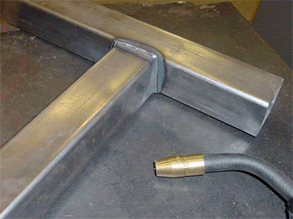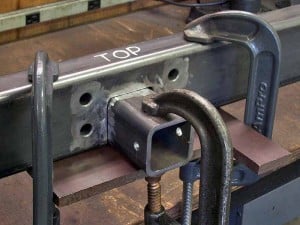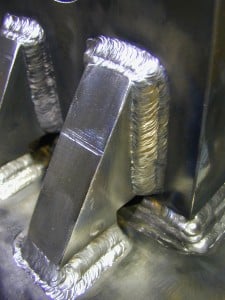Welding square tubing successfully can be accomplished in the same manner in which any other material is welded.
On a standard 45 degree corner, you will use one fillet weld, one corner weld and two flat welds.
There is no preparation work required on the two areas where the corner and fillet welds will be placed other than removing any rust, dirt or debris that may be in the weld area.
Before performing the two flat welds you will need to clean and bevel the metal being used.
The use of a bevel on the flat welds will ensure that you achieve proper penetration on both pieces of the square tubing being welded.
To begin the welding process you will need to cut two pieces of square tubing ensuring that both pieces have one 45 degree angled end.
To do this you will want to set your band saw on a 45 degree mitre cut.
Once you have properly set your band saw you will need to clamp the square tubing into the band saw vise.
After both of your pieces of square tubing have been mitred, you should now use your grinder with a 4 inch hard grinding wheel to remove any burr from all four sides of each piece of tubing that you cut.
Once this has been done you should now bevel each side of the square tubing that has been cut to a 45 degree angle.
After you have finished mitring the square tubing you should now place the two pieces of
square tubing on your flat work area with the mitre cuts facing each other.
Bringing the mitred sides of the tubing together you should leave a 1/16″ space between both pieces.
Next you will need to place a framing square at the corner that you created by joining the two pieces of tubing together at 90 degrees.
Once the framing square has been put into place you are now ready to power on your welding machine.
You should also take this time to put on all of your welding safety gear.
Once you are properly attired you can now begin welding using a tack weld on the inside point of the mitred corners at the fillet weld.
While welding the tubing together you should continuously check the corner against the framing square to ensure your corner is still at 90 degrees.
Now you should place a tack weld on the back of the mitred corner and another tack weld on the flat surface of the square tubing that has the 45 degree cut on it.
After you have successfully placed these tack welds you should now flip the piece over and perform the same tack welds on the back.
After the tack welds have been completed the next step is to weld the rear corner of square tubing first.
To do this you should place your MIG gun at the top of the corner and press the trigger, dragging the weld puddle downhill to perform the weld.
Once this has been completed, you will now want to spin the two pieces of square tubing and perform the fillet weld on the inside of the corner. Starting the weld at the top and dragging the weld downhill while moving the MIG gun in a circular pattern to stitch the weld evenly between both pieces of square tubing.
The 45 degree mitre cut should be welded flat by starting the weld at the inside corner and working the weld to the outside corner of the mitred joint.
After this step has been completed you should now flip the tubing over and weld the final flat 45 degree cut side.
Once you have completed all of the welding you can now grind the corners and have a perfect 90 degree bend in the square tubing.
Now this article talks about MIG welding, but if you are using aluminium you will need to look at an AC/DC TIG welder to do the job.
Before you decide to purchase a welding machine for the job, think about the time you are going to spend during the day with this machine on full power.
This should help you decide if you need to invest in a solid reliable European or USA made machine or a cheaper made import machine supplied more for the hobbyist.
From there you have to decide on a New or Used welder and out there the choice is endless.
If you want unbeatable value with a good back up service try buying from a reputable dealer of used and refurbished welding equipment.



